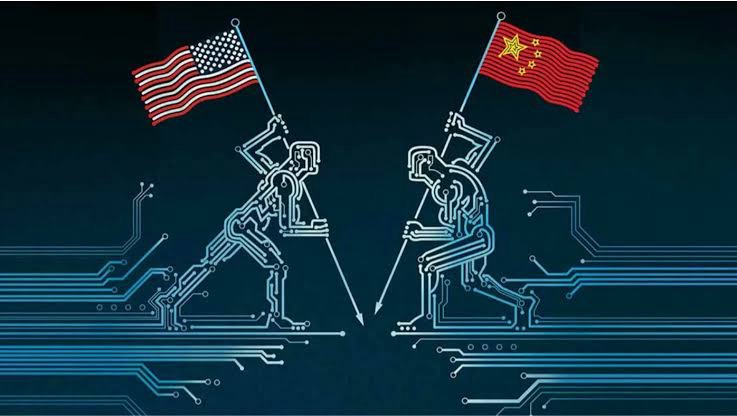The race for artificial intelligence (AI) dominance is more than just a technological arms race; it’s a battle of fundamental principles and societal visions. The divergent approaches to AI development, deployment, and governance between the United States and China have profound implications for global security, human rights, and economic prosperity. Understanding this critical dynamic, often termed US-China AI Ideology, is essential for navigating the complex future of AI. This post delves into the core ideological differences, the intense scrutiny they generate, and the pervasive bias concerns inherent in their respective AI ecosystems.
The competition isn’t merely about who develops the most advanced algorithms or biggest datasets. It’s about whose values will shape the global AI landscape, influencing everything from privacy norms to national security doctrines. As AI permeates every facet of life, the ideological underpinnings of its creation become paramount.
Understanding the Ideological Divide in AI Development
At the heart of the AI rivalry lies a fundamental divergence in political systems and societal priorities. The US-China AI Ideology clash is a reflection of democratic versus state-centric governance models applied to cutting-edge technology.
The US Approach: Democratic AI and Open Innovation
The United States largely champions an AI development model rooted in democratic values, emphasizing:
- Individual Rights and Privacy: A strong focus on data privacy, user consent, and protection against surveillance, though implementation can be challenging.
- Transparency and Accountability: Calls for explainable AI (XAI) and mechanisms to hold AI systems and their developers accountable.
- Private Sector-Led Innovation: AI research and development are primarily driven by tech giants and startups, fostering competition and rapid innovation.
- Ethical AI Frameworks: Emphasis on fairness, non-discrimination, and human oversight in AI design and deployment.
- Open Science and Collaboration: A tradition of open-source software and international scientific collaboration, albeit with growing national security caveats.
This approach often leads to robust debates on algorithmic bias and data ethics, reflecting a commitment to public scrutiny and democratic oversight.
China’s Approach: State-Centric AI and Social Control
In contrast, China’s AI strategy is deeply intertwined with its state-controlled system, prioritizing national interests, stability, and control:
- National Stability and Social Governance: AI is seen as a tool for enhancing social order, surveillance, and governance efficiency, often through extensive data collection.
- State-Led Development: The government plays a dominant role in setting AI priorities, funding research, and directing private enterprises towards national goals.
- Mass Data Collection: A less restrictive approach to data privacy, allowing for vast datasets to be collected and utilized for AI training, including facial recognition and social credit systems.
- Technological Sovereignty: An intense focus on achieving self-reliance in core AI technologies to reduce dependence on foreign components and software.
- Military-Civil Fusion: A policy of integrating civilian technological advancements with military applications, accelerating defense capabilities.
This distinct perspective raises significant global concerns regarding digital authoritarianism and the potential for AI misuse on a grand scale.
Scrutiny in the US-China AI Competition
The ideological differences fuel intense scrutiny from both sides, as well as from international observers. This scrutiny spans national security, economic competition, and ethical considerations, shaping the geopolitical landscape of AI.
Geopolitical Implications and National Security
The AI race is viewed through a national security lens by both Washington and Beijing. Concerns include:
- AI Arms Race: The development of autonomous weapons systems and the application of AI in intelligence gathering and cyber warfare.
- Supply Chain Vulnerabilities: Reliance on adversary’s AI hardware (e.g., chips) or software, posing risks of espionage or disruption.
- Global Standard Setting: The nation that leads in AI development is likely to shape global norms, regulations, and technical standards, giving it significant influence.
The ideological underpinnings of US-China AI Ideology directly impact how each nation perceives and mitigates these risks, leading to export controls, investment restrictions, and technological decoupling efforts.
Ethical Oversight and Human Rights
Perhaps the most critical area of scrutiny revolves around the ethical implications of AI, particularly concerning human rights:
- Surveillance Technologies: China’s extensive use of AI-powered surveillance, including facial recognition and predictive policing, draws heavy criticism for its potential to suppress dissent and monitor populations.
- Data Privacy Norms: The vastly different approaches to data collection and privacy create a fundamental disagreement on what constitutes ethical data use in AI.
- AI Misuse: Concerns about the potential for AI to be used for censorship, manipulation, or the reinforcement of discriminatory practices, regardless of intent.
Democratic nations scrutinize China’s AI ethics, while China often criticizes Western AI for perpetuating social inequalities or lacking robust national oversight.
Addressing Bias Concerns in AI Systems
Beyond the geopolitical rivalry, a universal challenge facing all AI development is algorithmic bias. This is an area of intense scrutiny, and both nations, albeit with differing priorities, must contend with its implications.
The Pervasiveness of Algorithmic Bias
AI systems learn from data, and if that data reflects existing societal biases, the AI will perpetuate and even amplify them. Examples include:
- Racial and Gender Bias: Facial recognition systems misidentifying individuals from minority groups, or hiring algorithms showing preference for certain demographics.
- Socioeconomic Bias: Predictive policing tools disproportionately targeting low-income neighborhoods or credit scoring algorithms disadvantaging certain populations.
- Data Collection Bias: Datasets lacking diversity or being collected under specific conditions that don’t represent the broader population.
Addressing these biases is crucial for fair and equitable AI systems, and the underlying US-China AI Ideology influences how these concerns are prioritized and regulated.
Mitigation Strategies and Ethical AI Frameworks
Efforts to combat AI bias involve multi-faceted approaches:
- Diverse and Representative Datasets: Ensuring training data reflects the full diversity of human experience to prevent skewed outcomes.
- Explainable AI (XAI): Developing methods to understand how AI systems make decisions, making it easier to identify and rectify biases.
- Ethical AI Guidelines and Regulation: Governments and organizations are developing frameworks and laws to promote fairness, transparency, and accountability in AI.
- Human Oversight and Auditing: Implementing human review points in AI-driven processes to catch and correct biased outputs before they cause harm.
- AI Ethics Research: Investing in research to understand the sources of bias and develop technical solutions for mitigation.
While the US emphasizes regulatory bodies and private sector self-regulation, China’s focus tends to be on top-down directives to achieve desired outcomes, though both recognize the necessity of mitigating bias for effective AI deployment.
Navigating the Future of US-China AI Ideology
The complex interplay of US-China AI Ideology, scrutiny, and bias concerns presents both challenges and potential pathways forward. While competition is inevitable, a complete decoupling may not be feasible or desirable, given the global nature of AI research and deployment.
Future engagement will likely involve:
- Managed Competition: Acknowledging the strategic rivalry while establishing guardrails to prevent escalation, especially in military applications of AI.
- Selective Cooperation: Identifying areas where collaboration is mutually beneficial or necessary for global well-being, such as AI for climate change, pandemic response, or disaster relief.
- Dialogue on AI Governance: Establishing channels for discussing ethical AI principles, data privacy, and the responsible development of AI, even amidst disagreements.
- Protecting Core Values: Upholding democratic principles and human rights in AI development and deployment, and advocating for these values internationally.
The world watches as these two AI superpowers shape the future, not just through technological advancement, but through the underlying philosophies that drive their innovation.
In conclusion, the discourse around US-China AI Ideology is more than an academic exercise; it’s a critical lens through which to understand the evolving global order. Addressing the scrutiny and bias concerns inherent in each nation’s approach will be vital for ensuring AI serves humanity ethically and equitably, rather than becoming a tool for division or control.


